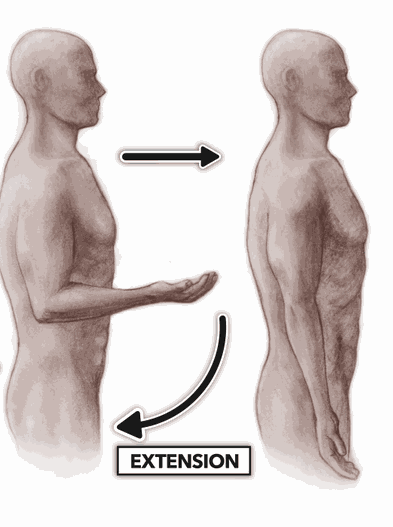What is the kinetic chain?
Let's consider three simple concepts to understand what a kinetic chain is.
Concept #1 - A system of linkages
Consider the human body to be made up of multiple rigid rods, all linked to each other via joints. All the rods rotate about the respective joint in certain specific ways based on what the structure of the joint allows.
Concept #2 - Torque - a force which rotates stuff
When you apply force against a free object, the object moves in the direction of the force. Now, what a force is to linear movement, a torque is to a rotational movement. Torque is force applied about a joint to cause rotation. So, when you apply torque at a joint in a certain direction, the joint rotates in that direction. Our muscles act as force producers. For example, when the triceps contract, a torque is exerted at the elbow joint causing the elbow joint to extend.

Concept #3 - Force and movement transmission
As all the rods are connected to each other via joints, force applied at one joint can transmit via the segment in between to another joint. For example, force applied at the elbow can move through the forearm to the wrist joint. This force acting at the new joint can cause movement at that joint too! However, this happens without the muscle responsible for that movement having to work.
Let's clarify with a simple example -
We have two muscles, M1 and M2, capable of exerting torques and causing rotations about two joints, J1 and J2 respectively. If we exert a torque at M1 and the force can travel from joint J1 to J2 via the segment in between, it can cause rotation at joint J2 as well, without M2 having to contract and produce torque. Thus, torque from one muscle M1 is causing rotations at two joints J1 and J2.
So finally, what is the kinetic chain? - It is this system of linked segments where forces and torques at multiple joints are capable of influencing movement at multiple other joints.
How is the kinetic chain relevant to badminton?
The kinetic chain and it's proper utilization is relevant not only to badminton, but to almost every sport in the world, especially those that involve any kind of throwing or similar overhead motion.
Let's take an example of the badminton jump smash.
The jump smash is a complex stroke, involving a lot of rotations, a few happening simultaneously and a few happening, one after the other. Generally, in complex movements, our body segments rotate in a proximal to distal sequence.
Firstly, what does proximal and distal mean? - Imagine the spine to be the centre line of the body. Proximal and distal are terms used to define relative locations of the segments and joints with respect to the centre line. For example, the trunk is more proximally located than the upper arm while the forearm is more distally located as compared to the upper arm.
Why is this relevant? - Because force in the body generally travels from the more proximally located segments to the more distally located segments. For example -
Trunk -> Shoulder -> Elbow -> Wrist -> Fingers
This sequence can also be observed in the following video of the badminton jump smash in slow motion (Youtube.com)
https://www.youtube.com/watch?v=hLwaHfjlojU
This, force or torque which acts at a proximal joint (For example, the force causing the rotation of the shoulder) can also influence rotation of a subsequent distal joint (wrist). For example, research on baseball pitching by Hirashima et al. (2008) found that elbow extension and wrist flexion were driven by a torque acting at the shoulder joint and trunk-pelvis joint.
Even though research hasn't been conducted on the badminton smash action, because of the similarity of badminton jump smash to the overhead throwing or pitching action, it can be hypothesized that distal joint rotations in a smash are also driven by proximally acting torques and forces.
This information becomes very important for coaches. While teaching a new skill in a sport as technical as badminton, they can tailor their instructions accordingly. Also, using the wrong driver of a particular rotation can put unnecessary and excess stress on the surrounding musculature and lead to injuries. For example, forcibly extending your elbow when performing a smash rather than focusing on shoulder internal rotation and just letting that motion subsequently cause elbow extension.
While the smash is just one example, the use of the kinetic chain in many other technical strokes (forehand, backhand clear etc) and supporting actions (lunges, two footed jumps etc) can be explained similarly.
Thus, ensuring right technique becomes crucial to maximize performance and prevent injuries in the long term. For more information on the right technique for the different strokes in badminton, stay tuned to badmintoo.com.
Follow us on Instagram - https://www.instagram.com/badmintoo_com/
Follow us on LinkedIn - https://www.linkedin.com/showcase/badmintoo-com/